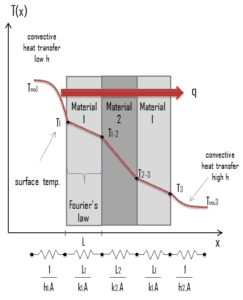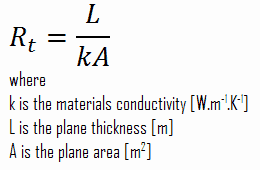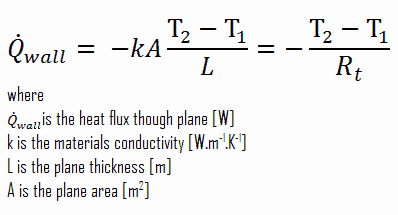R-value – Thermal Insulance Factor
Thermal resistance is a heat property and a measurement of a temperature difference by which an object or material resists a heat flow. The thermal resistance for conduction in a plane wall is defined as:
Since the concept of thermal resistance can be used in a variety of engineering branches, we define:
- Absolute thermal resistance, Rt, which has units of [K/W]. Absolute thermal resistance is a property of a particular component, which has defined geometry (thickness – L, area – A and shape). For example, a characteristic of a defined heat exchanger. Only a temperature difference is needed to solve for heat transferred.
- Specific thermal resistance or specific thermal resistivity, Rλ, which has units of [(K·m)/W]. Specific thermal is a material constant. Material thickness and a temperature difference is required to solve for heat transferred.
- R-value. R-value (thermal insulance factor) is a measure of thermal resistance. The higher the R-value, the greater the insulating effectiveness. Thermal insulance has the units [(m2.K)/W] in SI units or [(ft2·°F·hr)/Btu] in imperial units. It is the thermal resistance of unit area of a material. The R-value depends on the type of insulation, its thickness, and its density. An area and a temperature difference is required to solve for heat transferred.
R-value
The construction industry makes use of units such as the R-value (resistance), which is expressed as the thickness of the material normalized to the thermal conductivity, and under uniform conditions it is the ratio of the temperature difference across an insulator and the heat flux density through it: R(x) = ∆T/q. The higher the R-value, the more a material prevents heat transfer. As can be seen, the resistance is dependent on the thickness of the product.
Thermal Resistance – Thermal Resistivity
 In engineering, another very important concept is often used. Since there is an analogy between the diffusion of heat and electrical charge, engineers often use the thermal resistance (i.e. thermal resistance against heat conduction) to calculate heat transfer through materials. Thermal resistance is the reciprocal of thermal conductance. Just as an electrical resistance is associated with the conduction of electricity, a thermal resistance may be associated with the conduction of heat.
In engineering, another very important concept is often used. Since there is an analogy between the diffusion of heat and electrical charge, engineers often use the thermal resistance (i.e. thermal resistance against heat conduction) to calculate heat transfer through materials. Thermal resistance is the reciprocal of thermal conductance. Just as an electrical resistance is associated with the conduction of electricity, a thermal resistance may be associated with the conduction of heat.
Consider a plane wall of thickness L and average thermal conductivity k. The two surfaces of the wall are maintained at constant temperatures of T1 and T2. For one-dimensional steady heat conduction through the wall, we have T(x). Then Fourier’s law of heat conduction for the wall can be expressed as:
We hope, this article, R-value – Thermal Insulance Factor, helps you. If so, give us a like in the sidebar. Main purpose of this website is to help the public to learn some interesting and important information about thermal engineering.

